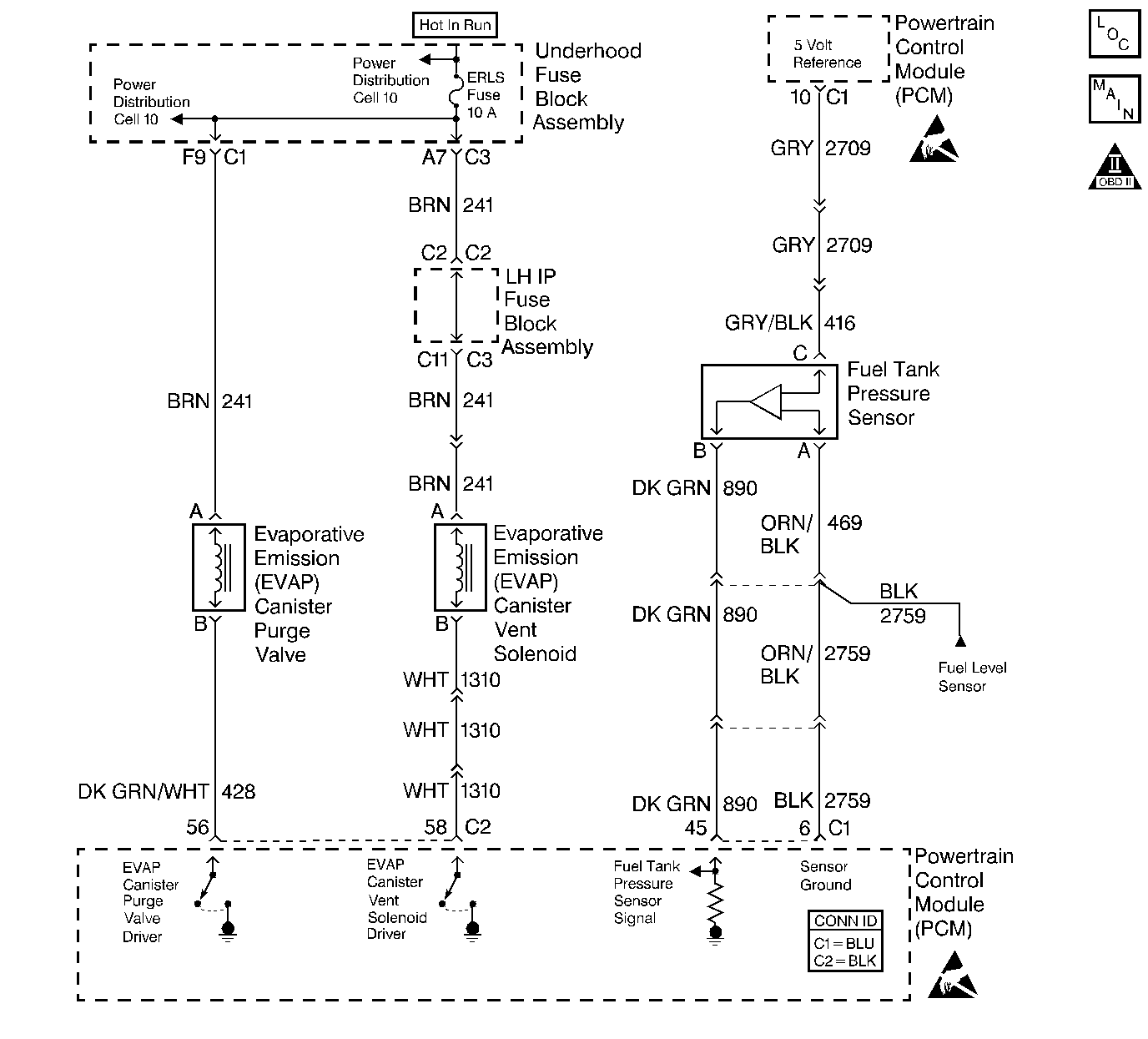
Diagnosis
| • | EVAP canister purge solenoid valve operation is covered in this section and diagnosed in DTCs P0440, P0446, and P1441. |
| • | EVAP vent solenoid operation is covered in this section and diagnosed in DTCs P0440, P0442, and P0446. |
| • | Fuel tank vapor pressure sensor operation is covered in this section and diagnosed in DTCs P0440, P0442, P0446, P0452, P0453, P1441 and Evaporative Emission System Check. |
| • | A open or shorted circuit in the EVAP canister purge solenoid valve and EVAP vent solenoid can also be diagnosed in Powertrain Control Module Outputs Diagnosis . |
Visual Check of the EVAP Canister
If cracked or damaged, replace canister. Refer to EVAP Canister Replacement .
Circuit Description
The evaporative emission system is checked by applying vacuum to the EVAP system and monitoring for a vacuum decay. The PCM monitors the vacuum level through the fuel tank vapor pressure sensor signal. At an appropriate time, the EVAP canister purge valve and the EVAP vent solenoid are turned ON, allowing the engine to draw a small vacuum on the entire evaporative emission system. After the desired vacuum level has been achieved, the EVAP canister purge valve is turned OFF, sealing the system. A leak is detected by monitoring for a decrease in vacuum level over a given time period, when all other variables remain constant. A leak, blockage or faulty component in the system will cause a DTC to be set.
Diagnostic Aids
Check for the following conditions:
| • | Poor electrical connection at PCM. Inspect harness electrical connectors for the following conditions: |
| - | Backed out terminals |
| - | Improper mating |
| - | Broken locks |
| - | Improperly formed |
| - | Damaged terminals |
| - | Poor terminal to wire connection |
| • | Damaged harness--Inspect the wiring harness for damage. If the harness appears to be OK, observe the Fuel Tank Vacuum Pressure display on the scan tool while moving electrical connectors and wiring harnesses related to the sensor. A change in the display will indicate the location of the malfunction. |
| • | Incorrect purge or vacuum source line routing. Verify that the source vacuum and purge lines to the EVAP canister purge solenoid valve are not switched. |
Step | Action | Value(s) | Yes | No |
|---|---|---|---|---|
1 | Did you perform the Powertrain On-Board Diagnostic (OBD) System Check? | -- | ||
2 |
Are any DTCs set? | -- | Go to DTC Diagnostic Tables first | |
3 |
Does the purge valve and the vent solenoid click when commanded ON and OFF? | -- | ||
4 |
Is the Fuel Tank Pressure at the specified value? | 0 mmHg (-2.4-2.4 mmHg) (-1.28-1.28 in. H2O) | Go to DTC P0452 Fuel Tank Pressure Sensor Circuit Low Voltage or | |
5 |
Important:: Before continuing with diagnosis, zero the EVAP Pressure and Vacuum gauges on the J 41413 EVAP pressure/purge Diagnostic Station (refer to tool operating instructions).
Important: Do not exceed the pressure given in the first specified value. Is the Fuel Tank Pressure at the second specified value? | 5 in. H2O (1.24 kPa) 12 mmHg (7.2-16.8 mmHg) (3.85-8.99 in. H2O) | Go to DTC P0452 Fuel Tank Pressure Sensor Circuit Low Voltage or | |
6 | Observe the EVAP system Pressure on the J 41413 EVAP pressure/purge Diagnostic Station while commanding the vent solenoid OFF (Open) with the scan tool. Does the EVAP system pressure decrease to the specified value within 5 seconds? | 0 in. H2O (0 kPa) | Go to DTC P0446 Evaporative Emission (EVAP) Vent System Performance | |
7 |
Is the Fuel Tank Pressure decreasing? | 1,500 RPM | Go to DTC P1441 Evaporative Emission (EVAP) System Flow During Non-Purge | |
8 |
Is the Fuel Tank Pressure decreasing? | 1,500 RPM | System OK If a driveability symptom exists, go to Symptoms |
